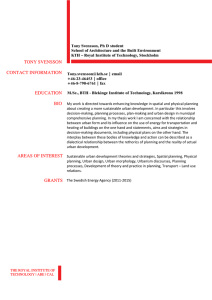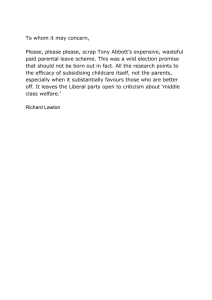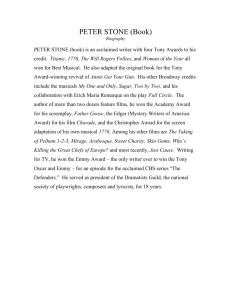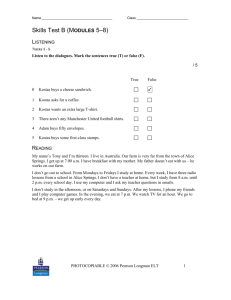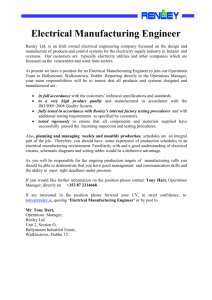Tony J. Cunha, 1916−1992: A Brief Biography
advertisement
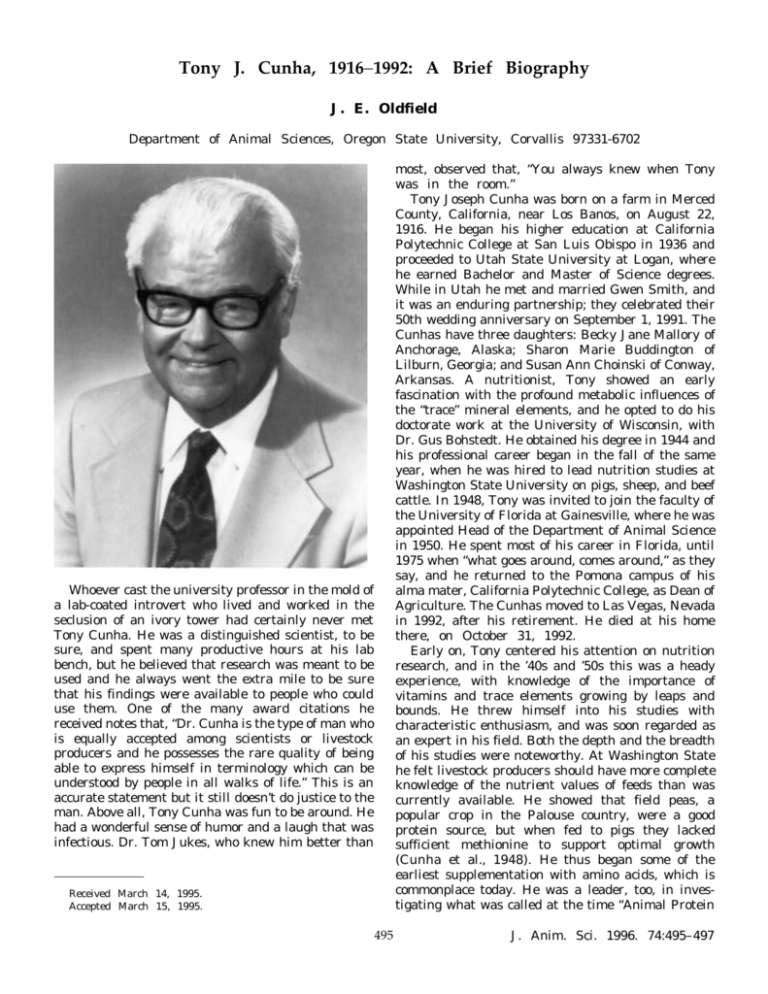
Tony J. Cunha, 1916−1992: A Brief Biography J. E. Oldfield Department of Animal Sciences, Oregon State University, Corvallis 97331-6702 most, observed that, “You always knew when Tony was in the room.” Tony Joseph Cunha was born on a farm in Merced County, California, near Los Banos, on August 22, 1916. He began his higher education at California Polytechnic College at San Luis Obispo in 1936 and proceeded to Utah State University at Logan, where he earned Bachelor and Master of Science degrees. While in Utah he met and married Gwen Smith, and it was an enduring partnership; they celebrated their 50th wedding anniversary on September 1, 1991. The Cunhas have three daughters: Becky Jane Mallory of Anchorage, Alaska; Sharon Marie Buddington of Lilburn, Georgia; and Susan Ann Choinski of Conway, Arkansas. A nutritionist, Tony showed an early fascination with the profound metabolic influences of the “trace” mineral elements, and he opted to do his doctorate work at the University of Wisconsin, with Dr. Gus Bohstedt. He obtained his degree in 1944 and his professional career began in the fall of the same year, when he was hired to lead nutrition studies at Washington State University on pigs, sheep, and beef cattle. In 1948, Tony was invited to join the faculty of the University of Florida at Gainesville, where he was appointed Head of the Department of Animal Science in 1950. He spent most of his career in Florida, until 1975 when “what goes around, comes around,” as they say, and he returned to the Pomona campus of his alma mater, California Polytechnic College, as Dean of Agriculture. The Cunhas moved to Las Vegas, Nevada in 1992, after his retirement. He died at his home there, on October 31, 1992. Early on, Tony centered his attention on nutrition research, and in the ’40s and ’50s this was a heady experience, with knowledge of the importance of vitamins and trace elements growing by leaps and bounds. He threw himself into his studies with characteristic enthusiasm, and was soon regarded as an expert in his field. Both the depth and the breadth of his studies were noteworthy. At Washington State he felt livestock producers should have more complete knowledge of the nutrient values of feeds than was currently available. He showed that field peas, a popular crop in the Palouse country, were a good protein source, but when fed to pigs they lacked sufficient methionine to support optimal growth (Cunha et al., 1948). He thus began some of the earliest supplementation with amino acids, which is commonplace today. He was a leader, too, in investigating what was called at the time “Animal Protein Whoever cast the university professor in the mold of a lab-coated introvert who lived and worked in the seclusion of an ivory tower had certainly never met Tony Cunha. He was a distinguished scientist, to be sure, and spent many productive hours at his lab bench, but he believed that research was meant to be used and he always went the extra mile to be sure that his findings were available to people who could use them. One of the many award citations he received notes that, “Dr. Cunha is the type of man who is equally accepted among scientists or livestock producers and he possesses the rare quality of being able to express himself in terminology which can be understood by people in all walks of life.” This is an accurate statement but it still doesn’t do justice to the man. Above all, Tony Cunha was fun to be around. He had a wonderful sense of humor and a laugh that was infectious. Dr. Tom Jukes, who knew him better than Received March 14, 1995. Accepted March 15, 1995. 495 J. Anim. Sci. 1996. 74:495–497 496 OLDFIELD Factor,” or APF, showing that this was a part of what caused the nutritional superiority of animal sources of protein over plant products. This work took an unexpected twist when he showed that fermentation residues from the production of aureomycin, sent him by Dr. Jukes from the Lederde laboratories, performed similarly to APF, and the concept of the “antibiotic growth effect” was born (Cunha et al., 1950). Dr. Cunha felt that livestock producers could not fully benefit from the new and expanding knowledge of the vitamins unless they could see what the effects of their deficiency was on their animals, and he conducted a number of purified diet studies to illustrate these. Among these investigations, he identified the peculiarly rigid “goose stepping” gait of affected pigs as indicative of a deficiency of pantothenic acid (Hodgskiss et al., 1950). He was concerned about the safety of some of the time-honored practices used with show animals to “put a shine on their coat,” such as the administration of arsenicals, and he provided some of the first controlled experimental evidence on their use (Kline et al., 1949). Dr. Cunha was a productive member of the animal nutrition research establishment in mid-20th century, a group that included such people as Mac Beeson, Wise Burroughs, Damon Catron, Ralph Elliot, Tom Jukes, and Helen Maddock, among others, who advanced nutritional knowledge on a broad scale. He threw himself into his studies with enthusiasm and was a popular speaker at scientific meetings. His real love, though, was writing, and he assembled an impressive list of publications, numbering over 1,500 at the time of his retirement. Among these were 20 books; their subject matter, though generally nutrition-oriented, was as broad and varied as their author’s career. One of his first, and perhaps his bestknown, work was Swine Feeding and Nutrition, which was published by Interscience in 1957. This became a widely-used text in courses in swine production. In 1960, it was translated into Spanish, becoming Alimentacion del Cerdo. He contributed to a threevolume treatise titled Chemistry, Physiology and Pathology of Vitamins that was published by Academic Press in 1954 and subsequently twice revised, and to Swine in Biomedical Research issued by the Battelle Memorial Institute, in Richland, Washington, in 1966. His literary skill led to enduring associations with publishing houses and other agencies benefiting from his talents. Academic Press appointed him editor of their series of books on animal feeding and nutrition, which included 14 texts by 11 different authors. The Salt Institute recognized his knowledge of mineral nutrition in selecting him to write their newsletter, which he did for 20 years. But the writing and editing assignment that probably gave him the most pleasure was his service on the Committee on Animal Nutrition for the National Research Council. Tony succeeded Mac Beeson to the chairmanship of this committee and his term was a most productive one. I served under him and remember nostalgically the thrill of accomplishment that he generated. He didn’t like delays. We would start work at the National Academy at eight sharp in the morning and work constantly ’til 6, or so, in the evening. When the day was over, though, Tony was not averse to our enjoying ourselves, and if we had a particularly productive day, he would provide a bottle of Mateus rosé, which, true to his Portuguese ancestry, he declared was the only really good wine. Dr. Cunha never felt the need to court recognition, but a great deal of it naturally came his way. He was elected President of the American Society of Animal Science in 1962 and earned its highest accolade, the Morrison Award, in 1968. He was elected a Fellow of the ASAS in 1971. He received no fewer than 11 Distinguished Service Awards with appropriate plaques and, in the case of one award from the Florida Bankers’ Association, a Stetson hat, which he wore with great pleasure and élan. His fluency in Portuguese led to an invitation to speak and advise on animal nutrition problems in Brazil, where he was honored with a medal, in Porto Allegre, in 1972. He was honored by both the national scholarly honor society, Phi Kappa Phi, and the agricultural honorary, Gamma Sigma Delta, which recognized him for International Service, in 1976. Even among all these marks of high distinction, one could always sense Dr. Cunha’s friendly, human touch, exemplified by such awards as “Boss of the Year” from the Gainesville chapter of the National Secretaries Association, in 1966 and the title of Honorary State Farmer, conferred by the California FFA organization, in 1980. His services to the University and the state of Florida were legendary and were marked by 18 different awards. Even this impressive list of honors is only a fraction of those he received, but merely identifying them does not bring out his remarkable personality. The real Tony Cunha is identified best by those who worked closely with him. Tony always wanted to be where the action was, and he generated a lot of that action himself. Al Pearson, who was with him at Utah State, remembers that in his graduate days there Tony lived in the Swine Barn. I recall that when the NRC decided to publish a set of Nutrient Allowances for Fish, Tony brought those of us on the Committee on Animal Nutrition at the time to Cook, Washington, high above the Columbia River, to rough out the publication with John Halver, who headed a fish nutrition lab there that was the center of action in that field. Gene Ensminger, who started Dr. Cunha on his professional career at Washington State University, wrote nostalgically of him: I remember Tony Cunha as one of the most unique and unforgettable personalities that I have ever known. I remember Tony when, fresh out of the graduate school at the University of Wisconsin, 497 TONY J. CUNHA he joined my staff at Washington State University, Pullman, in 1944. I remember Tony as a great teacher—the kind whose students would happily come at night for a make-up session. I remember Tony as a tireless research worker, who lived and breathed vitamin studies with swine. I remember Tony as a fun person. I remember him dressed as a chef and doing Texas-style pit beef barbecues for livestock events on the campus. I remember him baiting the campus police with his decrepit Maxwell car, which the officers often ticketed for no windshield wiper, or only one light, or for poor brakes. I remember Tony Cunha as a family man, a scholar, and a gentleman. I remember Tony as a star on the way up, who I had the pleasure of recommending to the University of Florida following his four years of yeoman service at Washington State University. I remember Tony Cunha as living again in the hearts of those he left behind. And Tom Jukes adds a heart-warming tribute: Somewhere, along the long pathway of life, we meet a few people who lighten our burden by their infectious warm nature, their laughter and their good fellowship. Tony Cunha was such a person. Those who knew him, and there were many, will always remember him with a happy smile. Good old Tony! Truly, Tony Cunha was a remarkable person, writer, research scientist, teacher and friend. He served this Society well, in many different capacities, as he did the states of Florida and California, the nation and the world. I miss him, but I am heartened that the influence of his work will continue, as will his memory in the hearts of his many friends and colleagues. Literature Cited Cunha, T. J., J. E. Burnside, D. M. Buschman, R. D. Glasscock, A. M. Pearson, and A. L. Shealy. 1949. Effect of vitamin B12, animal protein factor and soil for pig growth. Arch. Biochem. 28:324. Cunha, T. J., E. J. Warwick, M. E. Ensminger, and N. K. Hart. 1948. Cull peas as a protein supplement for swine feeding. J. Anim. Sci. 7:117. Hodgskiss, H. W., M. E. Ensminger, R. W. Colby, and T. J. Cunha. 1950. Inadequacy of purified diets for reproduction in swine with observations on an added deficiency of pantothenic acid. J. Anim. Sci. 10:619. Kline, E. A., M. E. Ensminger, T. J. Cunha, W. W. Heinemann, and W. E. Ham. 1949. Effect of adding drugs to the ration of fattening cattle. J. Anim. Sci. 8:411.

